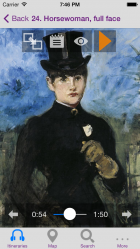
The 18th century brought with it a new taste in art, the Rococo style. France at this time was the centre of all that was deemed elegant. King Louis XV gave his name to a style that represented the end of the Baroque. It was mainly based on very rich and ornate decoration, with marble and gilt everywhere, particularly on furniture and on whimsical frames and mouldings. The decoration of Royal Palaces is a good example of the style, in which ovals and curves in general seem to pervade everything.
Among painters, the depiction of pretty, courtly scenes became widespread, with opulently dressed figures, heavily influenced by characters from the Commedia dell’ Arte, such as Pierrot and Harleqiun, and usually set in gardens. Watteau and Fragonard were the leading exponents of this style.
The Thyssen Museum offers us this lovely picture by Watteau. The scene is set in a garden, and the light falls on the figures, highlighting the beauty and richness of their clothing. In the centre, we can see a Pierrot. He was a typical character form the Italian Commedia, who represented freedom and who enjoyed music and company.
This was one of Baron Thyssen’s favourite paintings and he had it copied as the background to a portrait of himself by Lucien Freud.
(c) (R) 2013, MUSMon com S.L.
Text (a) Catalina Serrano Romero
Picture
Source: Wikimedia Commons
Author: DcoetzeeBot
Permission: This artwork is in the public domain: The author of this artwork died more than 70 years ago. According to E.U. Copyright Law, copyright expires 70 years after the author's death. In other countries, legislation may differ.
Independently produced by MUSMon.com, the audio guide for the Thyssen-Bornemisza Museum offers you a wide-ranging, light-hearted and educational tour of one of Spain’s most outstanding art museums. It contains 90 minutes of commentary, illustrated with over 52 high-quality images, so you won’t miss a single detail during your visit.
We will guide you on your journey through the history of painting. +info




































































